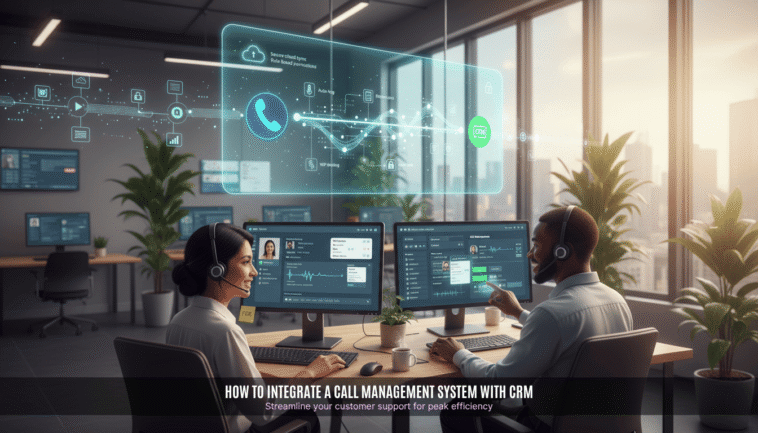Connect your Call Management System to your CRM, map the right fields, secure the sync, set up screen pops and auto‑logging, pilot with a small team, then improve weekly. Expect faster responses, more first‑contact resolutions, and fewer missed follow‑ups.
Why this integration matters
Right now, a lot of call info lives in different tools. That slows teams down. When calls flow into the CRM automatically, agents see everything in one place—history, tickets, orders, notes—so they help faster and ask fewer repeat questions. Leaders get clean reports. Follow‑ups happen on time. And customers feel the difference.
What this integration actually does
- One timeline for every customer: calls, notes, recordings, tickets, and tasks live together.
- Screen pops: when the phone rings, the correct CRM record opens with the context agents need.
- Auto‑logging: outcomes, duration, notes, and recordings save without manual typing.
- Smart routing: VIPs and specific issues reach the right person quickly.
- Analytics: track call performance with real business data, not just raw minutes.
Real outcomes teams see
- Faster replies because context is ready.
- More first‑contact resolutions because calls land with the right expert.
- Cleaner follow‑ups thanks to automatic tasks and reminders.
- Better coaching from consistent dispositions and recordings.
A simple 6‑step plan (start small, win fast)
1. Define success
Pick 2–3 goals: lower average handle time, increase first‑contact resolution, raise follow‑up completion. Keep it focused for phase one.
2. Map the data
Decide what moves between tools: caller ID, account/contact, call purpose, disposition, next step, due date, owner. Keep the fields short and clear.
3. Secure the connection
Use single sign‑on or OAuth, encrypted data, and role‑based permissions. Give “write” access only where needed. Keep an audit trail.
4. Configure the agent experience
Set screen pops for the right record, show open tickets/orders, enable click‑to‑dial, attach recordings to the right place, and keep the UI clutter‑free.
5. Pilot and train
Run a two‑week pilot with one team or queue. Hold short daily huddles to remove friction (a bad route, a missing field, a confusing outcome). Train on “why it helps” as well as “how it works.”
6. Measure, improve, expand
Watch AHT, FCR, transfer rate, repeat‑call rate, follow‑up completion, and CSAT. Fix one issue per week. Then roll out to more teams.
Day‑one automations that pay off
- Auto‑log every call with disposition, notes, and recording.
- Auto‑create tasks for missed calls and voicemails (with due dates).
- Auto‑open or update support tickets when a support disposition is chosen.
- Auto‑route VIP/high‑risk accounts to senior agents.
- Send post‑call SMS or email with links, confirmations, or booking options.
Advanced features (add as you grow)
- Intent‑based routing: send callers to the best skill group without long IVR menus.
- Real‑time guidance: pop short talk tracks or FAQs based on the call reason.
- Compliance helpers: pause/resume recording during sensitive info.
- Omnichannel view: keep voice, email, chat, and SMS in one CRM timeline.
What to measure (and why)
- First‑contact resolution (FCR): shows if routing + context are working.
- Average handle time (AHT): should drop as context improves.
- Transfer and repeat‑call rates: falling numbers = better accuracy up front.
- Follow‑up completion: proves automation is closing the loop.
- Disposition mix: surfaces training gaps and product issues to fix.
Common pitfalls (and quick fixes)
- Too many fields on screen: trim to essentials; hide the rest.
- Messy dispositions: lock a short, shared list; train everyone to use it.
- No clean transfer path: add one‑click transfers that keep context intact.
- Big‑bang rollout: pilot first, iterate weekly, then scale.
Security and trust (non‑negotiable)
- Role‑based access to recordings and sensitive data.
- Mask or skip recording during payment/ID entry.
- Retention policies by team/region; regular permission reviews.
Mini example (what “good” looks like)
A support team starts with one queue. They standardize outcomes, add screen pops, auto‑task missed calls, and route VIPs to a senior lane. In six weeks, average handle time falls, first‑contact resolution rises, and the “missed follow‑up” problem disappears. Weekly tweaks—not one giant project—make the difference.
Quick checklist to launch
- Goals and KPIs agreed
- Disposition list finalized
- Screen pops configured
- Routing and transfer rules tested
- Pilot team trained and scheduled
- Weekly review cadence set
Bottom line
Treat this integration like a product, not a one‑time task. Start small. Keep fields simple. Automate follow‑ups. Improve every week. Do that, and your Contact Center Software Solutions + CRM won’t just “sync”—they’ll help agents move faster, customers get answers sooner, and leaders make decisions with confidence.
This post was created with our nice and easy submission form. Create your post!




